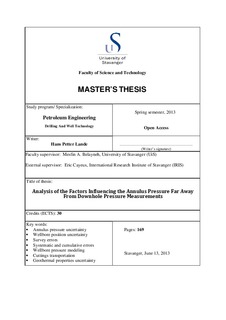| dc.description.abstract | In any drilling operation, it is important to maintain the annulus pressure within the geo-pressure margins (collapse and pore pressure on one side and fracturing pressure on the other side). The downhole pressure management may simply consist of limiting the operational drilling parameters (flow-rate, pump acceleration, rotational and axial velocities and accelerations of the drill-string) in such a way that the downhole pressure stays within the open hole formation pressure window.
In Practice, the downhole pressure is only sparsely measured, both in time and depth. With traditional mud pulse telemetry, it is only possible to have sensors in the direct vicinity of the MWD (Measurement While Drilling) tool and because of the low communication bandwidth, the measurement sampling interval is seldom better than half a minute. Even with the best downhole telemetry system available for drilling (wired pipe data transmission), the sampling interval is about five seconds and multiple pressure sensors, if any, are usually distant by 300 – 400 m. Considering that the speed of sound in drilling fluids is usually more than 1000m/s, it is not possible to capture, with currently available downhole pressure instrumentation, any of the transient pressure pulses that may cause problems during a drilling operation. To compensate for this deficiency, simulations of the downhole pressure using mathematical models are used to fill the gaps, in space and time, between the downhole and surface pressure measurements.
However there are external factors that influence the accuracy of such models. For instance, the actual wellbore position is derived from indirect measurements: the inclination, the azimuth and the measured depth at the measurement. These angles and length measurements can be biased by systematic errors that can result in a miscalculation of the position of the well. As a consequence, an over or under estimation of the actual vertical depth of the well may introduce discrepancies in the estimation of the downhole pressure. Other sources of inaccuracies are the actual temperature gradient along the well, the proportion of cuttings in suspension, the presence of gas in the drilling fluid, the variations of borehole size due to cuttings beds or hole enlargements. Any of these elements influences the accuracy of the pressure prediction made by models, especially at some distance from the downhole measurement location. This thesis presents quantitative and qualitative estimations of the influence of these factors on the pressure estimation accuracy. | no_NO |
